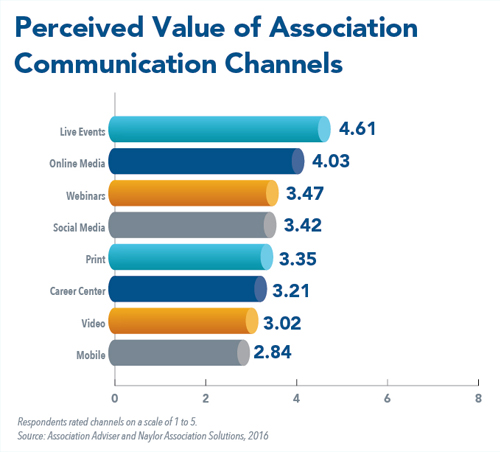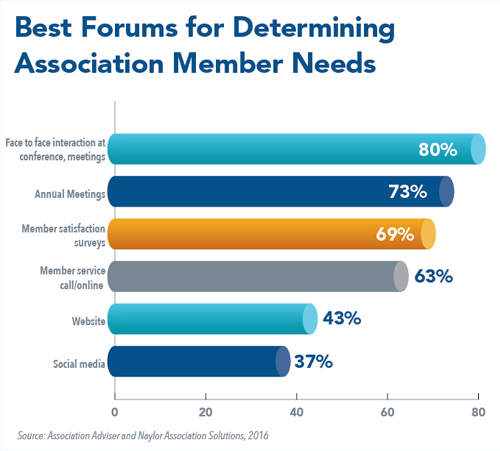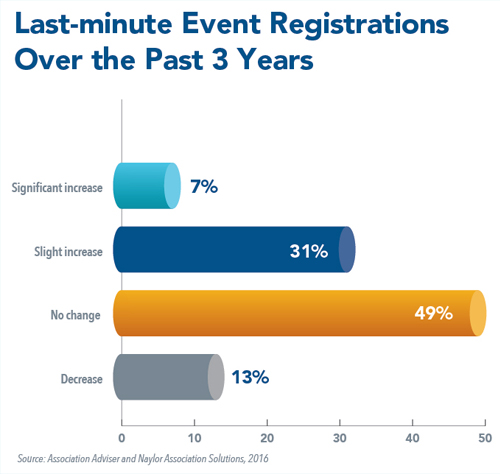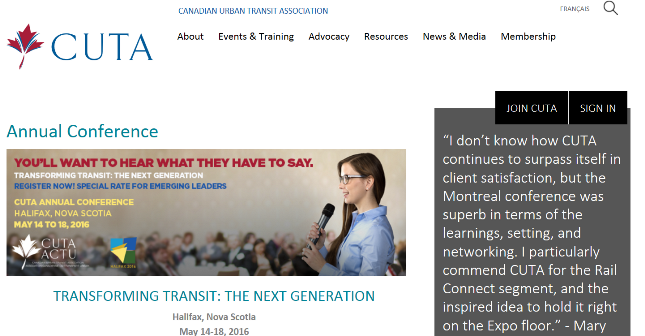Live Events Stronger Than Ever

But, our research shows event organizers continue to feel stressed as last-minute commitments rise.
You never know unless you go. For the sixth year in a row, our Association Communication Benchmarking study found that live events remain the most highly-rated member communication channel—by far—out of more than two-dozen studied.

Gregor Gomory, a business development leader for Naylor’s Global Exchange Events division, said he’s not surprised: “There’s no better way to engage with members than through a live event. It’s a perfect opportunity for people to see your association at its best and to reinforce its value to members. ‘This is why we’re here for you.’ It’s a great venue for reinforcing your brand and your value proposition.”

As shown above, at least three in four respondents to our annual association communication benchmarking study cited face to face interaction at live events and annual meetings as the best ways to take the pulse of member needs. An additional two-thirds of respondents cited member satisfaction surveys or member service calls/online interaction. Roughly two in five cited social media or the association website. Less than one in four respondents mentioned traditional focus groups, webinars, telephone surveys, insta polls or the Net Promoter Score.
Gomory agreed that live events are an ideal place to get “meaningful, no-holds barred feedback from your members,” and as Roger Dow, president and CEO of the U.S. Travel Association (ASTA) explains in his recent column for us, “there’s no technology that can replace a handshake.”
![]()
Our research shows live events remain the No.1 member communication vehicle for associations. ![]()
More attendees and exhibitors are waiting until the last minute to commit. ![]()
Put yourselves in attendees’ shoes and ask, “What would wow us? What would make our experience better?” ![]()
Give new members and other first-time attendees a guided tour pre-event. ![]()
Tired of last minute registrations? Tap into members’ FOMO (Fear of Missing Out) ![]()
Live events still resonate in a social, tech driven world
John Gallagher, group vice president, Naylor Event Solutions, said that nothing will take the place of live events. “Even in the techy worlds of comics and gaming, Comic Con and SXSW still continue to be monster events,” he said. “The more industrial trade shows still whir with machines and manufacturing. One of the largest reasons to attend, above wanting to kick the tires on a new combine, is networking. Peer to peer interaction is a driving force and face to face networking will never be replaced by online [communication tools].”
Roger Rickard, founder of Voices in Advocacy told Sarah Sain in the May 31 issue that “face to face meetings build relationships the way technology can’t. They create a shared sense of mission and purpose, while creating camaraderie that builds success.”
According to Gomory, technology doesn’t change the fact that there’s no substitute for (in person) face time. “When you’re interacting with someone at an event, there’s no phone, email or administrative assistant to distract them. It’s a vastly superior experience to even group Skype calls.”
Angela Kisskeys, Marketing and Communications, Associations North (formerly MSAE) agreed. “Live events provide a platform to create a deeper connection. They provide us a much needed break from the constant tech driven communication vehicles.”
Jodi Ray, director of business development for cloud-based learning solutions provider Blue Sky eLearn agreed with our other experts that learning-based networking opportunities are an important part of live events’ appeal. “I was just at a conference in which attendees, who were sitting at round tables, were encouraged to have group discussions with each other, apply the learning the just received to bring it home.”
This is especially important for government employees, a key cohort for many associations, who are increasingly seeing their travel budgets cut. Citing a Meetings Mean Business survey, USTA’s Dow writes that 92 percent of federal employees believe that attending live events helps them do their jobs better.
Patrick Leclerc, President & CEO of the Canadian Urban Transit Association (CUTA) concurred. “A few years ago we shifted to having more roundtables and discussions instead of just delivering content in a session with three panelists at the front. The feedback from members about this new format has been very good. They really want to learn from their peers as well as from the experts. We know that conferences are a great place to network, but there needs to be a takeaway. You need to approach conferences as a learning opportunity, not just as a networking opportunity. When I go around the country to meet with members, I ask them what their top priorities are, what are your key challenges and how can we help you achieve your business goals? That’s where the roundtable ideas come from.”
New wrinkles found on the live event scene
Kisskeys said Associations North has experimented with “open concept”’ tradeshow and session layouts, as well as “no pipe and drape” shows, unique settings to provide for memorable experiences. “We try to put ourselves in attendees’ shoes and ask, ‘What would wow us? What would make our experience better?’” said Kisskeys.
Naylor’s Gallagher said he experienced a very interesting session at the National Association of Music Merchants (NAMM) show in Nashville. “It’s a very noisy event by its nature, yet they were able to hold learning sessions with Q&A right on the show floor by giving audience members headphones to hear the panelists who had mics and headphones.” Gallagher said he was further impressed because the in-hall learning sessions drew crowds of people curious to view what appeared to be a “silent” session.
Event numbers are up, but so are last minute commitments
While associations reported steady increases in their events business over the past three years, nearly two in five (38 percent) have experienced a noticeable increase in last minute registrations and exhibit bookings.

Gallagher said that while it’s true registrations are coming in later and later, if you’re following best practices, there’s no need to worry. “Incentives to register earlier are good and some shows will not let hotel rooms be booked without registering first. That’s one way to ensure attendance.” However, he said new, first-time events are much scarier now.. “It’s really a roll of the dice until you get close to the event. By that time, you are usually fully committed cost-wise,” said Gallagher.
“That’s the nature of the beast,” said Gomory. “We’re used to it,” he said. “However, we have an advantage in that space at our [buyer-seller exchange events] is limited. When we reach our cap, we close off registrations.”
Kisskeys said Associations North offers incentives to register early (lower rate, access, a chance to win a prize). “We have also held firm in our cancellation policies as last minute changes and cancellations are difficult [for organizers] before an event. Late registrations mean your association should be doing more to encourage early sign up.”
As noted in the May episode of Association Adviser TV, consider offering potential attendees a sneak preview of an upcoming session or show a short video clip or graphic of what they’ll experience at your event.
Also, play into their FOMO (Fear of Missing Out). Randy Fiser, CEO of the American Society of Interior Designers says ASID uses a number of different mechanisms to play on members’ FOMO. “We are always watching the marketplace for really effective speakers. We are always looking to our members to suggest people that they come in contact with.”
How to increase repeat attendees
Kisskeys said that pre- and post-event engagement is crucial. “Hype the event before. Encourage the use of social media, sharing and connecting to create excitement. After the event, share highlights and get attendees talking about the event. Photos are always a great way to share your story. Talking about the event frequently keeps the buzz alive.”
Gallagher suggested rewarding repeat exhibitors and attendees for their loyalty. “Any kind of recognition works, whether it’s a direct discount or an added value.” He also cited the importance of surveying attendees and exhibitors. “Quite often the reasons associations think people attend or exhibit are very different from the actual reasons. If you really listening to the feedback attendees share with you, you need to act on it promptly.” Kisskeys agreed that, “attendees and exhibitors will come back if they saw value, had a great experience and felt a connection.”
Global Exchange Events’ Gomory said his group faces the opposite challenge. “We’re always striving to bring new blood (buyers) in to our exchange events. We want the suppliers to be repeat attendees, however. For traditional event planners seeking to improve their repeat attendance, Gomory recommended focusing on keeping attendees continuously engaged with the event via networking, entertainment, meals, etc., and not let them wander off.” He also suggested “striking while the iron is hot” when it comes to on-site registrations for the following year’s event.
Encouraging NextGen to attend
During our Corner Office interview with Patrick Leclerc, we asked about the use of a photo of a young woman holding a microphone on the registration page for CUTA’s recent annual spring conference Transforming Transit.

“Yes, that was by design,” said Leclerc. “We’re not just focused on the next generation of transit, but on the next generation of customers and the next generation of workers. We don’t very often give Millennials the mic and ask them directly, what’s important to you in life? What do you expect in the workplace? How do you move around your community and what do want your community to look like? That’s what attendees and policy makers need to hear.
As noted in this month’s episode of Association Adviser TV, you can encourage younger members to attend by offering entertainment they relate to, plus gamification and by providing student discounts among other perks. Fiser said that before a live event, ASID gives young members a guided tour of the trade show “so they can experience from a seasoned professional what they should be looking for in their conversations with vendors in the showcase.”
Bringing the events to attendees
Our annual research study found that 74 percent of associations believe social media is important for building awareness of live events and 39 percent believe it’s important for keeping non-attendees up to date about what’s happening at the live event. We also learned that half of associations that responded (52 percent) agree that it’s import to capture video at their live events.
Blue Sky’s Jodi Ray, said her company helped the Tax Executives Institute (TEI) stream two recent live events simultaneously. Live attendees in a Washington, DC venue were able to watch presentations and Q&A sessions from another TEI live event in a New York City venue—and vice versa. “It was like passing the microphone back and forth and experiencing the best of both [events] in person,” remarked Ray.
Another spin on the hybrid event notion is to use remote presenters for a live event. Ray said Blue Sky helped a large scientific organization, which had many government members who are often constrained by travel restrictions, present their informational posters virtually to a conference they couldn’t attend. Attendees could walk up to a webcam and the presenter would discuss the contents with them. Two dozen short, but high impact presentations, were successful conducted this way, said Ray.
Leclerc said that when associations are planning a conference, they must enable attendees to network in a more sophisticated manner. You want them to maximize the chance of meet someone who has a solution to their problem or vice versa, instead of randomly being in a room and hoping to find someone with whom you have something in common.
Conclusion
Of course chance encounters can be some of the most valuable connections you’ll make at an event—encounters that never would have occurred if you had not attended the event in person. Gomory recalled after one show, the shared car he was riding to the airport broke down in heavy traffic. During the 90-minute delay, two attendees, who had never met before, hammered out a multimillion dollar deal in the seat behind him. For more examples, see my 2014 piece explaining why you should always take the shuttle bus.
Maybe Woody Allen, the dark comic filmmaker was right when he said, “90 percent of life is showing up.”
Hank Berkowitz is the editor-in-chief of Association Adviser.

